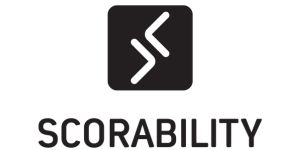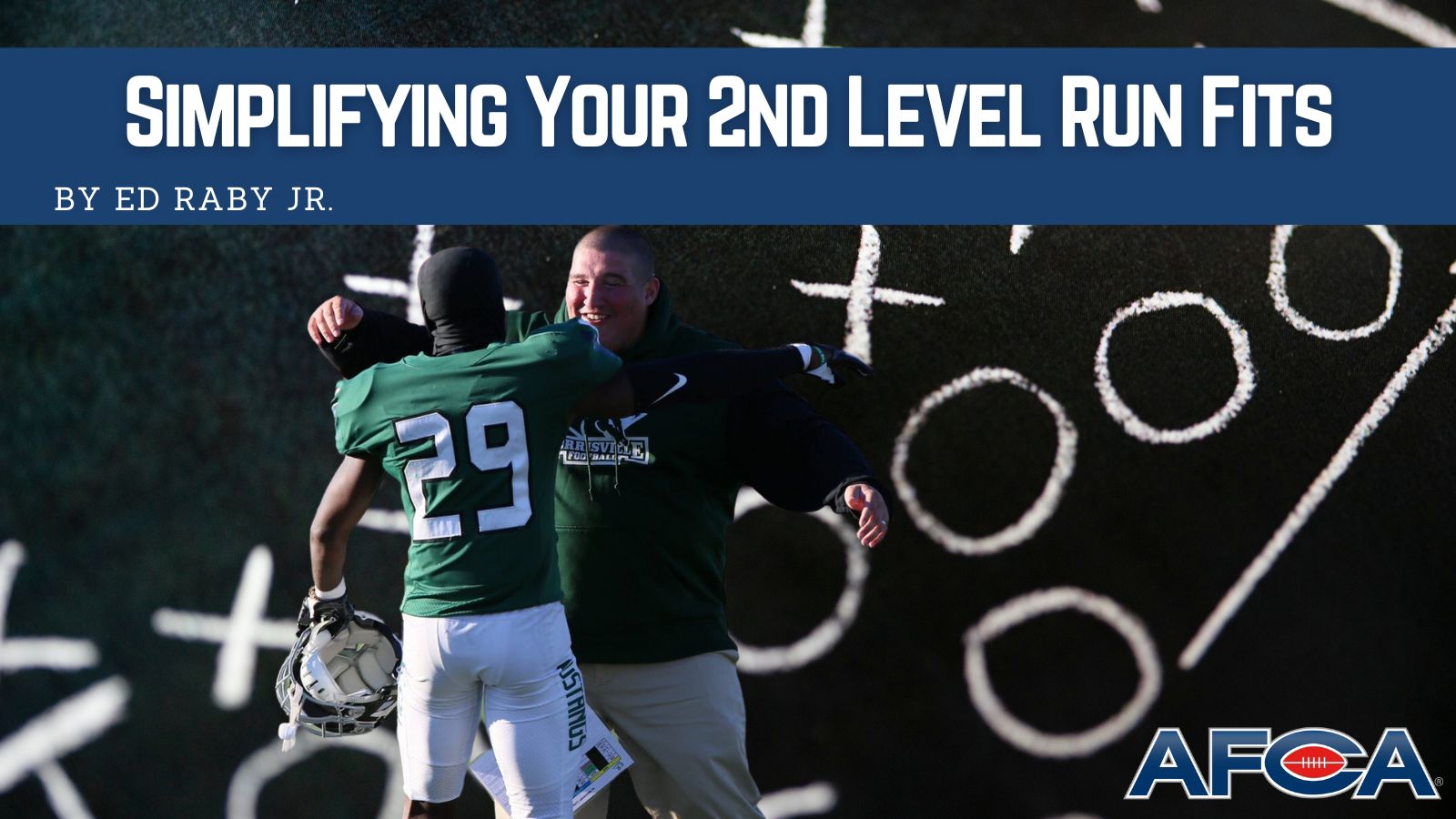
Simplifying Your 2nd Level Run Fits
May 9, 2023
One of the biggest questions for any defense is figuring out how to teach 2nd Level Run Fits. The challenge this presents stems from the multiplicity of the game of football. You need a consistent run-fit system that allows your players to play fast but also allows you to adapt to the complex nature of football. This article will examine the run fit concepts we have worked with for several years. Our run-fit system allows a defense to get players playing fast while giving the proper flexibility to have a multiple-defensive scheme.
Gap Fits vs Concept Fits
The first thing to decide as a defense, when it comes to run fits, is whether to be a gap-based team or a concept-based team. Both come with their advantages and disadvantages. We believe that being a concept-based team allows for several advantages.
- Gap fits are more ridged while concept fits are flexible. We want players to play with instinct. Often when you teach a player that they have a gap they feel locked in on that gap. Some may be able to understand nuance, but it relies on thinking and processing lots of information in real-time. This can make a player play slower than usual. With concepts defining what leverage to fit the run with, it allows for built-in flexibility. Players have a clear expectation that allows them to play intuitively and fast.
- Gaps move and change while concepts stay consistent. One of the main reasons concepts can be simple is their consistency. A fit concept stays consistent regardless of run scheme, formation, etc. A gap player must understand that in certain situations the gap will move or change…split run concepts, gap concepts, etc. can force gap teams to have players thinking about where their gap is. This creates chances for slow play.
- Gap fits require a massive memory load with front/stunt/blitz calls while concept fits remain unchanged regardless of front/stunt/blitz calls. Inevitably defenses will have stunt/blitz calls and multiple fronts. If you teach gaps this will require players to memorize different gaps and responsibilities for all those calls. Add in the complexity of offenses, and now you have a high number of variables that players must “think” about during play. Perhaps the best advantage of run fit concepts is their ability to remain unchanged no matter how multiple your defense is. A concept is set up as a set of guidelines based on a few factors…these don’t change. They are used the same for any defensive call.
The Force/Fold Player
We define the force player as a player who is aligned as the widest underneath defender outside the run box. Their concept is to maintain near-shoulder leverage on the ball carrier. Their alignment predetermines that the shoulder they must leverage is inside of them. Whether it is the outside or inside shoulder of the ball carrier is determined by if the run is “away” or “to” them.
- Run To: Attack the outside shoulder of the ball carrier. Make a tackle or force a significant change of direction.
- Run Away: The player will “hold” by buzzing their feet. This hold allows them to defend against RPO concepts as the QB reading them will not see them attacking the run-on run away. Once the ball is handed off the force/fold player will fold looking for the first available gap and is responsible for cutback, reverse, or trick play.
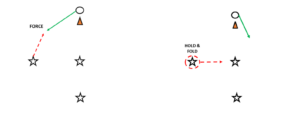
The Spill Player
The spill player is simply defined. Due to the nature of the spill, all runs as a spill player are categorized as “Run Away.” The spill player is any 2nd level defender aligned over the ball. Their job is to pursue all runs fitting inside out on the near hip of the ball carrier.
- Run Away: Get to the ball inside out. Traditional cloudy/clear read…if cloudy play over the top of all blocks. If clear hit it aggressively and make the tackle.
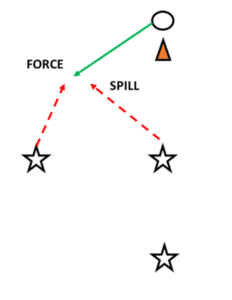
The Stack Player
The stack player is one of our unique concepts. We feel it necessary to make a distinction between non-force players that are aligned out of the run box and the force player. This is a player that is aligned outside the box that has a force player outside of him and a spill/vice player inside of him.
- Run To: We decipher between downhill run to, and wide flow run to for the stack player. If it is downhill to you; you will attack the outside shoulder of the ball carrier just like a force player. If wide flow to you, we want him to attack downhill to force the issue… get in a spill relationship.
- Run Away: The player will “hold” by buzzing their feet. This hold allows them to defend against RPO concepts as the QB reading them will not see them attacking the run on run away. Once the ball is handed off the stack player will fold looking for the first available gap and is responsible for cutback, reverse, or trick play.
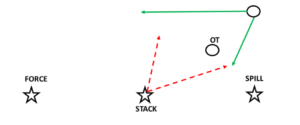
The Vice Player
Throughout the game, there will be coverages and calls that align our inside linebackers in a double 30 alignment or 40’s. If aligned in 50 the player would be considered a “Stack” player. When in the double 30 alignment we tell our ILBs that they are in a “Vice” run fit concept. With any run inside the box, these two players are working together to send the ball back to their fellow teammate. Once the run is wide flow both players will pursue as “Spill” players.
- Run To: Get to the ball carrier keeping shoulders square and making the tackle. Any lead blockers attack the block with the inside shoulder keeping the outside arm free to send it back to the other Vice player.
- Run Away: Get to the ball inside out. Traditional cloudy/clear read…if cloudy play over the top of all blocks. If clear hit it aggressively and make the tackle.
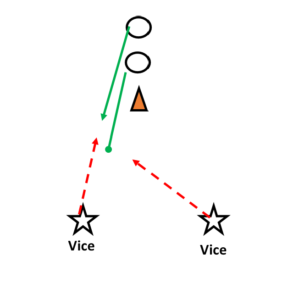
Coverage Examples with Run Examples
Below I will include a couple of coverage diagrams with their run fits labeled to illustrate how this works within a defensive scheme. I will then diagram one run player to illustrate how the run fits would work out based on the concepts each player has within the coverage called. In that example, I will explain in detail their run reaction based on their fit rule. For simplicity in reading, I have not included their coverage responsibilities on the diagram.
Cover 3 Strong Rotation Example
Will= Force/Fold
Mike = Spill
Sam = Stack
SS= Force/fold
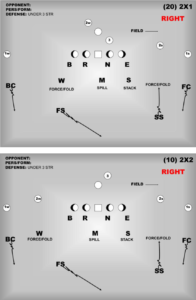
Cover 2 Example *Note* The corners are only forced as we do not expect them to fold
Field Corner/Boundary Corner = Force
Will= Vice/Stack/Spill based on alignment
Mike = Vice/Stack/Spill based on alignment
Sam = Stack
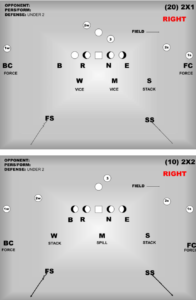
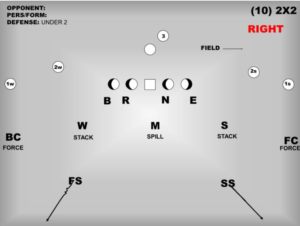
Cover 3 vs. Power Fit Example
In the following diagram, we see 20 personnel power vs. 3 Strong. The diagram is drawn based on the assumption that the QB has handed the ball off. In these situations where we have a numbers advantage; we would expect them to run an RPO. This article is meant to explain run-fits, so we will focus on an assumed handoff.
Strong Safety
Roll down to play his Force/Fold responsibility. Once he sees run to, he will start to fold inside flat. In the below diagram, the slot attacks him. The strong safety cannot pick a side before the ball is declared, so he would strike the blocker ready to shed the block once the ball is declared.
Sam LB
The “Stack” player gets a downhill run. He should be aggressive downhill and to the outside shoulder of the ball carrier in this situation. If the ball is properly spilled by the DE he will anticipate the bounce by the ball carrier. Some coaches will over-coach the fit on the puller here. Our stack player operates under the knowledge that he can be aggressive and has helped to his inside from the spill player and the outside from the force player. We will be comfortable in whatever way he fits on that puller.
Mike LB
The “Spill” player. All runs are considered run away; he must play the ball carrier inside out. He will scrape on run away playing the cloudy/clear technique. If he sees it clear he will aggressively fill, if cloudy he continues to scrape. In most cases against power that clearing will happen right over the double team. He will have to typically rip across the face of the tackle as that is who the offense is double-teaming to. On occasion he will fit inside the double; this is fine because our Will is going to see his clearing based on how the Mike fits.
Will LB
The weak side “Force/Fold” player. On run away he will hold and then once the handoff is given play run away rules maintaining leverage on the ball carrier’s backside hip looking for the first open gap. Folding flat, he will now play the cloudy/clear technique. Typically, if the Mike gets over top of the double the Will fits on the inside of the double for cutback as that will be what looks clear to him. If the Mike fits inside the double the Will most likely will see it as cloudy and scrape over the top of that double team.
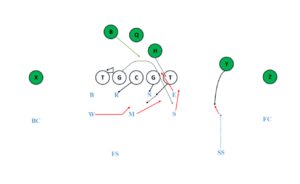
Conclusion
We use the words typically and most likely because we know the game of football is three-dimensional. We cannot predict offensive or defensive mistakes. Every play can be wildly different in football even if it is the same call. The run-fit concept does not change though, and each player knows how he should fit on the ball carrier. Ultimately, the goal of the run-fit concepts is to allow the players to play fast and react; we do not want them thinking and playing slow.
For more information about the AFCA, visit www.AFCA.com. For more interesting articles, check out The Insider and subscribe to our weekly email.
If you are interested in more in-depth articles and videos, please become an AFCA member. You can find out more information about membership and specific member benefits on the AFCA Membership Overview page. If you are ready to join, please fill out the AFCA Membership Application.
« « Previous PostNext Post » »
One of the biggest questions for any defense is figuring out how to teach 2nd Level Run Fits. The challenge this presents stems from the multiplicity of the game of football. You need a consistent run-fit system that allows your players to play fast but also allows you to adapt to the complex nature of football. This article will examine the run fit concepts we have worked with for several years. Our run-fit system allows a defense to get players playing fast while giving the proper flexibility to have a multiple-defensive scheme.
Gap Fits vs Concept Fits
The first thing to decide as a defense, when it comes to run fits, is whether to be a gap-based team or a concept-based team. Both come with their advantages and disadvantages. We believe that being a concept-based team allows for several advantages.
- Gap fits are more ridged while concept fits are flexible. We want players to play with instinct. Often when you teach a player that they have a gap they feel locked in on that gap. Some may be able to understand nuance, but it relies on thinking and processing lots of information in real-time. This can make a player play slower than usual. With concepts defining what leverage to fit the run with, it allows for built-in flexibility. Players have a clear expectation that allows them to play intuitively and fast.
- Gaps move and change while concepts stay consistent. One of the main reasons concepts can be simple is their consistency. A fit concept stays consistent regardless of run scheme, formation, etc. A gap player must understand that in certain situations the gap will move or change…split run concepts, gap concepts, etc. can force gap teams to have players thinking about where their gap is. This creates chances for slow play.
- Gap fits require a massive memory load with front/stunt/blitz calls while concept fits remain unchanged regardless of front/stunt/blitz calls. Inevitably defenses will have stunt/blitz calls and multiple fronts. If you teach gaps this will require players to memorize different gaps and responsibilities for all those calls. Add in the complexity of offenses, and now you have a high number of variables that players must “think” about during play. Perhaps the best advantage of run fit concepts is their ability to remain unchanged no matter how multiple your defense is. A concept is set up as a set of guidelines based on a few factors…these don’t change. They are used the same for any defensive call.
The Force/Fold Player
We define the force player as a player who is aligned as the widest underneath defender outside the run box. Their concept is to maintain near-shoulder leverage on the ball carrier. Their alignment predetermines that the shoulder they must leverage is inside of them. Whether it is the outside or inside shoulder of the ball carrier is determined by if the run is “away” or “to” them.
- Run To: Attack the outside shoulder of the ball carrier. Make a tackle or force a significant change of direction.
- Run Away: The player will “hold” by buzzing their feet. This hold allows them to defend against RPO concepts as the QB reading them will not see them attacking the run-on run away. Once the ball is handed off the force/fold player will fold looking for the first available gap and is responsible for cutback, reverse, or trick play.

The Spill Player
The spill player is simply defined. Due to the nature of the spill, all runs as a spill player are categorized as “Run Away.” The spill player is any 2nd level defender aligned over the ball. Their job is to pursue all runs fitting inside out on the near hip of the ball carrier.
- Run Away: Get to the ball inside out. Traditional cloudy/clear read…if cloudy play over the top of all blocks. If clear hit it aggressively and make the tackle.

The Stack Player
The stack player is one of our unique concepts. We feel it necessary to make a distinction between non-force players that are aligned out of the run box and the force player. This is a player that is aligned outside the box that has a force player outside of him and a spill/vice player inside of him.
- Run To: We decipher between downhill run to, and wide flow run to for the stack player. If it is downhill to you; you will attack the outside shoulder of the ball carrier just like a force player. If wide flow to you, we want him to attack downhill to force the issue… get in a spill relationship.
- Run Away: The player will “hold” by buzzing their feet. This hold allows them to defend against RPO concepts as the QB reading them will not see them attacking the run on run away. Once the ball is handed off the stack player will fold looking for the first available gap and is responsible for cutback, reverse, or trick play.

The Vice Player
Throughout the game, there will be coverages and calls that align our inside linebackers in a double 30 alignment or 40’s. If aligned in 50 the player would be considered a “Stack” player. When in the double 30 alignment we tell our ILBs that they are in a “Vice” run fit concept. With any run inside the box, these two players are working together to send the ball back to their fellow teammate. Once the run is wide flow both players will pursue as “Spill” players.
- Run To: Get to the ball carrier keeping shoulders square and making the tackle. Any lead blockers attack the block with the inside shoulder keeping the outside arm free to send it back to the other Vice player.
- Run Away: Get to the ball inside out. Traditional cloudy/clear read…if cloudy play over the top of all blocks. If clear hit it aggressively and make the tackle.

Coverage Examples with Run Examples
Below I will include a couple of coverage diagrams with their run fits labeled to illustrate how this works within a defensive scheme. I will then diagram one run player to illustrate how the run fits would work out based on the concepts each player has within the coverage called. In that example, I will explain in detail their run reaction based on their fit rule. For simplicity in reading, I have not included their coverage responsibilities on the diagram.
Cover 3 Strong Rotation Example
Will= Force/Fold
Mike = Spill
Sam = Stack
SS= Force/fold

Cover 2 Example *Note* The corners are only forced as we do not expect them to fold
Field Corner/Boundary Corner = Force
Will= Vice/Stack/Spill based on alignment
Mike = Vice/Stack/Spill based on alignment
Sam = Stack


Cover 3 vs. Power Fit Example
In the following diagram, we see 20 personnel power vs. 3 Strong. The diagram is drawn based on the assumption that the QB has handed the ball off. In these situations where we have a numbers advantage; we would expect them to run an RPO. This article is meant to explain run-fits, so we will focus on an assumed handoff.
Strong Safety
Roll down to play his Force/Fold responsibility. Once he sees run to, he will start to fold inside flat. In the below diagram, the slot attacks him. The strong safety cannot pick a side before the ball is declared, so he would strike the blocker ready to shed the block once the ball is declared.
Sam LB
The “Stack” player gets a downhill run. He should be aggressive downhill and to the outside shoulder of the ball carrier in this situation. If the ball is properly spilled by the DE he will anticipate the bounce by the ball carrier. Some coaches will over-coach the fit on the puller here. Our stack player operates under the knowledge that he can be aggressive and has helped to his inside from the spill player and the outside from the force player. We will be comfortable in whatever way he fits on that puller.
Mike LB
The “Spill” player. All runs are considered run away; he must play the ball carrier inside out. He will scrape on run away playing the cloudy/clear technique. If he sees it clear he will aggressively fill, if cloudy he continues to scrape. In most cases against power that clearing will happen right over the double team. He will have to typically rip across the face of the tackle as that is who the offense is double-teaming to. On occasion he will fit inside the double; this is fine because our Will is going to see his clearing based on how the Mike fits.
Will LB
The weak side “Force/Fold” player. On run away he will hold and then once the handoff is given play run away rules maintaining leverage on the ball carrier’s backside hip looking for the first open gap. Folding flat, he will now play the cloudy/clear technique. Typically, if the Mike gets over top of the double the Will fits on the inside of the double for cutback as that will be what looks clear to him. If the Mike fits inside the double the Will most likely will see it as cloudy and scrape over the top of that double team.

Conclusion
We use the words typically and most likely because we know the game of football is three-dimensional. We cannot predict offensive or defensive mistakes. Every play can be wildly different in football even if it is the same call. The run-fit concept does not change though, and each player knows how he should fit on the ball carrier. Ultimately, the goal of the run-fit concepts is to allow the players to play fast and react; we do not want them thinking and playing slow.
For more information about the AFCA, visit www.AFCA.com. For more interesting articles, check out The Insider and subscribe to our weekly email.
If you are interested in more in-depth articles and videos, please become an AFCA member. You can find out more information about membership and specific member benefits on the AFCA Membership Overview page. If you are ready to join, please fill out the AFCA Membership Application.


